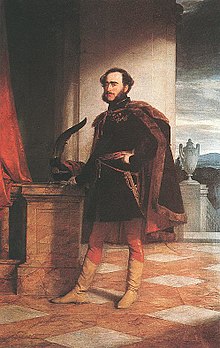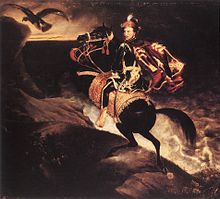István Széchenyi

Gróf Széchenyi István ([ ˈseːʧeːɲi ˈiʃtvaːn ], German also Count Stephan Széchenyi ); (Born September 21, 1791 in Vienna ; † April 8, 1860 in Döbling ) was a Hungarian state reformer and entrepreneur. Influenced by Jeremy Bentham and Adam Smith , he devoted himself entirely to economic progress in Hungary from 1825 in order to catch up with the West, and to improve the position of the Hungarian nation within the Habsburg monarchy . This commitment earned him the honorary title "Greatest Hungarian" from his competitor and temporary adversary Lajos Kossuth , which is still used today.
Life

Széchenyi was born into a rich Hungarian aristocratic family in Vienna. His enlightened father Ferenc Széchényi donated his own collections to the Hungarian nation in 1802 and thus founded the Hungarian National Museum and the National Library . His mother Julianna Festetics was the sister of György Festetics , who campaigned for the promotion of Hungarian literature and in 1797 in Keszthely on Lake Balaton founded Hungary's first agricultural college, the Georgikon .
As a child, István Széchenyi was more of a late developer, he could barely read at the age of 12, but later mastered six languages, although he had a much better command of German and French than Hungarian. As a young man, Széchenyi began a career in the military. He fought in wars against Napoleon, including the Battle of the Nations near Leipzig , and distinguished himself as a Rittmeister. But when he was denied the rank of major, he turned to his new mission in life: the renewal of his nation.
In 1814 the young high aristocrat began extensive traveling. The two poles of these trips were England, at that time the most industrially developed country in Europe, and Turkey. Széchenyi found British institutions - from horse racing to the industrial economy - to be exemplary. As a graduate reformer, he became the leading figure of the liberal movement in Hungary in the first half of the “age of reform”. After his travels, Széchenyi staged the first horse race in Hungary in 1827 . In the second half he lost his leading position to the radical Lajos Kossuth , who finally led Hungary into the revolution of 1848/49 . The sensitive Count Széchenyi got caught up in a romantic love story in 1824 with Countess Seilern (married Zichy), who resided in the Buda Castle District , and whom he married in 1836 after the death of her husband. (The Hungarian writer Ferenc Herczeg (1863–1954) wrote his play A Híd (“The Bridge”) about it , in which, somewhat shortened, he traced Széchenyi's commitment to the bridge connection between Buda and Pest named after him to this great love.)
Szechenyi was undoubtedly a romantic figure and prone to depression; However, he was also a rational political analyst who for years warned with clairvoyance that Kossuth would lead the country with his impetuosity into a catastrophe. During the revolution, Széchenyi broke down mentally. He spent the last eleven years of his life in a mental hospital in Döbling near Vienna. He evaded the grip of the authorities, who threatened to transfer him to a public asylum based on a sharply worded anonymous pamphlet (“Blick”), by suicide.

bronze by István Szentgyörgyi, Hungarian National Museum, Budapest
The undated medal shows a portrait of Count István Graf Széchenyi with the Széchenyi Chain Bridge and refers to Ferenc Herczeg 's play "The Bridge" (1925)
Since 1834 he was an honorary member of the Bavarian Academy of Sciences .
Works
Criticism of the feudal system
Széchenyi's work Hitel (German: Über den Credit ), which appeared in 1830 and received an unusually strong response for that time, discussed the reasons for Hungary's economic backwardness. In it he criticized Austria's customs policy, the lack of credit and the maintenance of noble privileges at the expense of the people. The inalienability of aristocratic property makes mortgage credit on such land impossible, and the resulting lack of credit does not allow industrialization. This is a consequence of the feudal system and an old constitutional law called " aviticity ". Széchenyi's work was aimed at creating new framework conditions under public law for the strengthening of the economy. In his books Világ ("Light") and Stadium , he put together a concrete reform program aimed at stricter implementation of the law and the abolition of tax exemption for nobles. In 1858, while in exile in Vienna, Széchenyi wrote a “look back” on the said retrospect, which was published anonymously in London, by the powerful Interior Minister Alexander von Bach on the Hungarian Revolution from 1848 to 49, which was also published anonymously. In it, Széchenyi reckoned with the failure of Bach's attempt to smash Hungary under neo-absolutism . The sharply worded work did, however, contain passages that could be interpreted as an insult to majesty . Finally, Széchenyi's diaries (mainly written in German) are an important historical and biographical source.
Promoting the economy
Széchenyi never possessed political power, with the exception of the post of transport minister during the brief period of government under Prime Minister Lajos Batthyány in 1848. As a private entrepreneur and member of the Bratislava State Parliament , however, he initiated many projects to improve transport routes and beautify the city of Budapest so that it became societal Would be the center of Hungary. He initiated the first permanent bridge between Buda and Pest, the Chain Bridge , which was to be built by means of a joint-stock company. The fact that the Bridge Act of 1835 obliged all passers-by, including the nobles, to pay the bridge toll, acted as an egalitarian signal. Széchenyi also promoted steam shipping, led the work on the Danube and Tisza regulation, set up a casino in Pest where intellectuals met to exchange opinions (first chef Franz Sacher , father of Eduard Sacher , founder of the Hotel Sacher in Vienna), initiated the establishment of the National Theater and offered his annual income for the establishment of the Hungarian Academy of Sciences in Pressburg .
Environment and impact
Kossuth
Lajos Kossuth was a revolutionary with whom Széchenyi came into conflict in the 1940s and had a major political debate in the press. The debate mainly concerned questions about the independence of Hungary within the monarchy as a whole and about the Magyarization of ethnic minorities. Széchenyi warned his compatriots about the consequences of language nationalism and a separation from Austria. In view of the catastrophes in the 20th century, which completely swept across Eastern Europe, he demonstrated a remarkable foresight with this position.
Metternich
Széchenyi tried again and again to win the Viennese government over to his plans. In Archduke Joseph , the Habsburg Palatine (imperial administrator) of Hungary, he had a benevolent sponsor for a long time. The authoritative statesman of the time, Prince Metternich , on the other hand, considered the Count to be a rebellious spirit that was aiming at the division of the empire. The State Chancellor correctly interpreted the signs of the epoch, but he was wrong in assessing personality. Széchenyi was too cautious and too loyal to the government for a strengthening Hungarian national feeling.
Appreciations
Bear Széchenyi's name:
- Budapest's Széchenyi Spa
- the Budapest Széchenyi Chain Bridge , the construction of which he initiated
- the Széchenyi museum railway from Fertőboz to the Nagycenk castle , the ancestral seat of the noble Széchenyi family, in memory of its services to the Hungarian transport system
- the Széchenyi Museum in Nagycenk Castle
- the István Széchenyi University in Győr (originally a university for transport and telecommunications).
- the Széchenyi István High School in Sopron and Pécs
- His portrait is shown on the circulating 5000 forint note of the Hungarian State Bank as well as on older banknotes from the interwar period.
- Szechenyi monument in Siófok
family
Count Széchenyi and Countess Seilern had two children together:
- Count Bela Stephan Maria Széchenyi de Sarvar-Felsövideki (1837–1918) ∞ Countess Johanna Gobertine Erdödy
- Count Ödön (Edmund) Széchenyi de Sárvár-Felsövidék (1839–1922) ∞ (2) Eulália Christopoulos
The entrepreneur Gloria von Thurn und Taxis (* 1960), Maya Flick, Carl Graf von Schönburg-Glauchau and the journalist Alexander Graf von Schönburg-Glauchau (* 1969) are Széchenyi's great-great-grandsons.
literature
- Constantin von Wurzbach : Széchenyi, Stephan . In: Biographisches Lexikon des Kaiserthums Oesterreich . 41st part. Kaiserlich-Königliche Hof- und Staatsdruckerei, Vienna 1880, pp. 251–289 ( digital copy ).
- Denis Silagi: The greatest Hungarian: Count Stephan Széchenyi. Herold Verlag, Vienna / Munich 1967.
- Andreas Oplatka: Count Stephan Széchenyi. The man who made Hungary. Zsolnay Verlag, Vienna 2004, ISBN 3-552-05317-4 .
- I. Fazekas, S. Malfèr, P. Tusor (eds.): Széchenyi, Kossuth, Batthyány, Deák. Studies on the Hungarian reform politicians of the 19th century and their relations with Austria. (= Publications of the Hungarian historical research in Vienna. Volume 3). Collegium Hungaricum, Vienna 2011, ISBN 978-963-88739-6-5 .
- Z. Szász: Széchenyi von Sárvár and Felsővidék István (Stephan) Gf .. In: Austrian Biographical Lexicon 1815–1950 (ÖBL). Volume 14, Verlag der Österreichischen Akademie der Wissenschaften, Vienna 2012–, ISBN 978-3-7001-7312-0 , p. 131 f. (Direct links on p. 131 , p. 132 ).
Web links
- Literature by and about István Széchenyi in the catalog of the German National Library
- Entry about István Széchenyi in the Hungarian Biographical Lexicon (MEK) of the National Széchényi Library (Hungarian)
- A look at the anonymous "Rückblick" (ascr. To B. Mayer with corrections by A. Bach) which ... 1857, in Vienna, was published by a Hungarian (gróf I. Széchenyi, ed. By FK) , (Google Books)
- Széchenyi István: Oriental Journey (1818–1819)
- Something about Hungary , hedge branch, Pesth 1839
- Robert Schediwy : A man of balance. Count István Széchenyi and his Nagycenk Castle near Sopron. Wiener Zeitung from July 20, 2001
Individual evidence
- ↑ A Hungarian aristocrat - Széchenyi István . Hungary-Guide.com
-
↑ Denis Silagi: The greatest Hungarian: Count Stephan Széchenyi. Herold Verlag, Vienna / Munich 1967
* Nagycenk. “The place of residence of the 'Greatest Hungary' (Lajos Kossuth called him that) is only 12 km away from Sopron [...] In front of the church is the bronze statue of István Széchenyi, which was made by the sculptor Alajos Stróbl. A few meters from here, in the parish cemetery, is the Széchenyi mausoleum, where 'the greatest Hungarian' and many members of the Széchenyi family have found their eternal rest. ” ( Hungariantourism.com ( Memento from January 25, 2009 in the Internet Archive ), accessed August 14, 2010)
* “ On the 150th anniversary of the death of István Széchenyi, our chamber exhibition gives our visitors an insight into the most important stages in the life of 'the' greatest Hungary '.” ( Budapest Tourist Office: Budapestinfo.hu ( Memento of April 28, 2010 in the Internet Archive ), accessed August 14, 2010) - ↑ "A happy ending with tears" ( Memento from January 14, 2013 in the web archive archive.today ) Paul Lendvai on the history, mentality and future of Hungary in the Wiener Zeitung from July 20, 2001, accessed on June 26, 2010.
- ↑ Fine Arts in Hungary (→ ABC Index → Szentgyörgyi István → Works by István Szentgyörgyi → Ferenc Herceg (reverse) → " I ")
- ↑ Available as an e-book , accessed on February 5, 2011.
- ↑ A look at the anonymous "Rückblick", which appeared for a familiar circle in relatively few copies in October 1857 in Vienna, by a Hungarian , ed. and foreword by FK
| personal data | |
|---|---|
| SURNAME | Széchenyi, István |
| ALTERNATIVE NAMES | Széchenyi, Gróf István (full name); Széchenyi, Count Stephan |
| BRIEF DESCRIPTION | Hungarian state reformer and entrepreneur |
| DATE OF BIRTH | September 21, 1791 |
| PLACE OF BIRTH | Vienna |
| DATE OF DEATH | April 8, 1860 |
| Place of death | Dobling |

